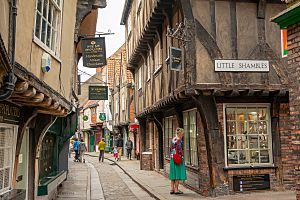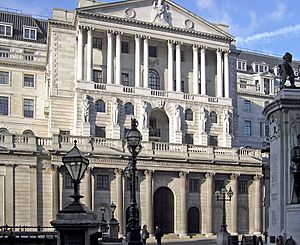Economy of England facts for kids

The City of London, the financial capital of England, and the United Kingdom as a whole
|
|
| Currency | Pound sterling (£) |
|---|---|
| 1 April to 31 March | |
| Statistics | |
| Population | 57,106,398 (2022) |
| GDP | £2.162 trillion (2022) |
|
GDP per capita
|
£37,852 (2022) |
|
Labour force
|
28,081,000 / 74.9% in employment (Jan–Mar 2024) |
|
Labour force by occupation
|
List
27.0% Professional
15.1% Associate professional 11.2% Managers, directors and senior officials 9.5% Administrative and secretarial 9.1% Elementary occupations 8.6% Skilled trades 7.8% Caring, leisure and other service 6.1% Sales and customer service 5.3% Process plant and machine operatives (Jan–Dec 2023) |
| Unemployment | 1,298,000 / 4.4% (Jan–Mar 2024) |
|
Average gross salary
|
£683.40 per week (2023) |
| External | |
| Exports | £539.2 billion (2021) |
|
Export goods
|
List
£92.8bn Machinery and transport
£40.2bn Chemicals £31.8bn Miscellaneous manufactures £28.6bn Manufactured goods £14.2bn Mineral fuels £8.6bn Food and live animals £7.4bn Crude materials £2.3bn Beverages and tobacco £0.4bn Animal and vegetable oils £0.0bn Other commodities £226.4bn Total (2021) |
|
Main export partners
|
List
£110.5bn European Union
£42.2bn Asia & Oceania £39.1bn North America £11.9bn Middle East and North Africa (excl. EU) £10.3bn Western Europe (excl. EU) £5.0bn Eastern Europe (excl. EU) £3.9bn Sub-Saharan Africa £3.2bn Latin America and Caribbean £0.2bn Undefined country group £226.4bn Total (2021) |
| Imports | £535.9 billion (2021) |
|
Import goods
|
List
£124.5bn Machinery and transport
£56.9bn Miscellaneous manufactures £51.0bn Manufactured goods £42.6bn Chemicals £35.6bn Mineral fuels £29.9bn Food and live animals £12.0bn Crude materials £5.5bn Beverages and tobacco £1.3bn Animal and vegetable oils £0.1bn Other commodities £359.4bn Total (2021) |
|
Main import partners
|
List
£178.6bn European Union
£86.9bn Asia & Oceania £34.0bn Western Europe (excl. EU) £30.3bn North America £10.0bn Middle East and North Africa (excl. EU) £8.0bn Eastern Europe (excl. EU) £7.1bn Sub-Saharan Africa £4.4bn Latin America and Caribbean — Undefined country group £359.4bn Total (2021) |
The economy of England is the biggest part of the United Kingdom's economy. England's economy is one of the largest and most active in the world. In 2022, the average income per person (called GDP per capita) was about £37,852.
The government's money matters are handled by His Majesty's Treasury. This department is led by the Chancellor of the Exchequer. They create and carry out plans for how the government spends money and manages the economy. Other important government groups involved are the Department for Business and Trade and the Department for Science, Innovation and Technology.
England has a social market economy. This means it uses many ideas from free markets, where businesses can operate freely. But it also has a strong system to help people, like healthcare and welfare. England is a very industrialised country. It leads in areas like high-tech industries, chemicals, and medicines. It's also strong in aerospace (making planes and spacecraft), the arms industry, and software manufacturing.
A lot of England's money comes from the City of London. This area is a global hub for banking, insurance, and other money-related services. The UK's technology sector is worth a huge US$1 trillion, and most of this is based in England. This makes it the third largest tech sector in the world, after the United States and China.
The service sector is the largest part of England's economy. This includes things like construction, technology, and business services. These areas keep growing and help the economy. Creative industries are also very important. These include arts, film, fashion, music, and IT. England has the second largest creative industry sector in Europe.
In the 1700s, England was the first country to become industrialised. This was during the Industrial Revolution. Like many other developed countries, England now relies less on manufacturing and mining. Since the 1990s, financial services have become much more important. The City of London is now one of the world's biggest financial centres. Banks, insurance companies, and trading markets are all found there.
The London Stock Exchange is England's main stock market and the largest in Europe. Many of Europe's biggest companies are based there. The official money in England is the pound sterling, which is the oldest currency still used today.
Contents
- Understanding England's Economy
- Key Economic Areas
- Money and Taxes
- Regions and Cities
- Images for kids
Understanding England's Economy
England is a country within the United Kingdom. The UK is part of several important international groups. These include the Commonwealth of Nations, the G7, the G20, and the World Trade Organization.
What is GDP?
Gross Domestic Product (GDP) is a way to measure the total value of goods and services produced in a country. It helps us compare how wealthy different countries are. Since England is part of the UK, its GDP figures are usually combined with Scotland, Wales, and Northern Ireland.
Here's a look at the GDP for the UK and its parts in 2021:
| Region | (trillion £) |
|---|---|
| Total UK GDP | 2.3 |
| England (including London) | 2.0 |
| England (excluding London) | 1.43 |
| London | 0.53 |
| Scotland | 0.17 |
| Wales | 0.08 |
| Northern Ireland | 0.05 |
A Brief History of England's Economy
In medieval times (from about the 11th to 15th centuries), the wool trade was England's main business. England sold a lot of wool to Europe. This helped many market towns and ports grow.
Later, in the late 1700s and early 1800s, things changed a lot. New canals and railways were built. This helped England become the world's first industrialised nation. During this time, England also expanded its empire. It used resources like cotton and tobacco from colonies like India and America. English factories then turned these resources into goods to sell at home and abroad. Big industrial cities grew, especially in the Midlands and Northern England.
Key Economic Areas
England's economy is made up of many different parts, called sectors. Let's explore some of the most important ones.
Food and Drink Industry
The food and drinks industry is a big part of England's economy. In 2021, it was worth £10.2 billion. The main types of food and drinks England exports are:
- Farm products and fish
- Alcoholic drinks (like gin and whisky)
- Hot drinks (like coffee and tea) and spices
Ireland is the top country that buys food and drinks from England. Exports to France and the USA have also grown.
Farming and Fishing
Farming in England is very modern and efficient. It uses machines and produces 60% of the food England needs. Only a small number of people (2%) work in farming. Two-thirds of farming is for raising animals, and the rest is for growing crops. The main crops are wheat, barley, oats, potatoes, and sugar beets.
England also has a large fishing industry. Its boats catch many kinds of fish, from sole to herring. The country also has natural resources like coal, petroleum, natural gas, and iron ore.
Alcoholic Drinks
England is becoming known for its wines and spirits. In 2022, England sold 800,000 bottles of English wine to other countries. This was worth £9.6 million. Popular English wine brands include Chapel Down and Ridgeview.
England also has many distilleries, which make spirits. There are more distilleries in England (311) than in Scotland (214). This is partly because English gin has become very popular. English whisky is also growing. By 2024, it's estimated that £1 billion worth of English whisky will be aging in barrels.
Manufacturing and Industry
England is a leader in many industrial areas. These include services, manufacturing, construction, farming, and tourism. The Industrial Revolution started in England, focusing first on textiles. Then came heavy industries like shipbuilding, coal mining, and steelmaking.
Today, manufacturing is still important, but it makes up a smaller part of the economy. England still builds luxury boats from brands like Princess and Sunseeker.
Car and Engine Making
The car industry in the UK employs about 800,000 people. It made £70 billion in 2015. England produces many luxury cars like Rolls-Royce, Bentley, and Range Rover. It is also the world's fourth-largest exporter of engines.
Motorsport and Technology
The motorsport industry in England is also very strong. It employs about 41,000 people. Seven out of ten Formula One racing teams are based in England. Their technology is even used in supercars like McLaren and Aston Martin.
England spends a lot on research and development (R&D). This helps new technologies grow. The UK was ranked in the top 5 countries for innovation in 2023. London is Europe's fastest-growing technology hub. England has over 100 tech companies worth $1 billion or more.
Many tech companies are based in London, especially in an area called East London Tech City, or Silicon Roundabout. Investment in London's tech sector has grown a lot.
Building and Construction
The construction industry in England employed about 2 million people in 2019. It added £123.2 billion to the economy.
One of the biggest recent construction projects was Crossrail. This new railway line, now called the Elizabeth line, runs through London. It cost about £19 billion and was the largest construction project in Europe. Another big project happening now is the High Speed 2 (HS2) railway line.
Money and Finance

England's financial services industry is very important. It adds a lot of money to the UK economy. England's capital, London, is a major global financial centre. The Bank of England is located in the City of London.
The London Stock Exchange is England's main stock market. It is the largest in Europe. Over 500 banks have offices in London. It is a top place for banking, insurance, and trading different currencies. London's financial services are mainly in the City of London and Canary Wharf.
Canary Wharf used to be old docks. Now it has huge offices and banks like Barclays Bank and HSBC. London is also a major centre for other business services, including law firms.
Outside of London, Leeds is England's second largest financial centre. It has over 30 national and international banks. Manchester also has a large financial sector.
Renewable Energy
England is working hard to reduce carbon dioxide emissions. The country is great for wind energy. Wind power is the fastest-growing energy source in England. In 2019, renewable energy sources provided almost 39% of the UK's electricity.
England is home to Hornsea 2, the world's largest offshore wind farm. It is located off the coast of Yorkshire. The Climate Change Act 2008 made it a legal requirement for the UK to cut its emissions. The goal is to have "net zero" greenhouse gas emissions by 2050.
Shopping and Retail
By the 1600s, permanent shops started to replace markets. Over time, shops began to look more like they do today, with counters and displays. After the Great Fire of London in 1666, shops were allowed on the main streets, known as "High Streets."
The 1800s were a "golden era" for High Street shops. As more middle-class people emerged, shopping became a popular activity. Today, shopping centres are places to meet friends and enjoy recreational shopping.
The retail sector includes car sales, repairs, and household goods. In 2016, High Street spending made up about 33% of what people spent. Online shopping is very popular in the UK, making up 22% of all retail spending. This is the third highest in the world.
Four main companies dominate the grocery market in England: Tesco, Sainsbury's, Asda, and Morrisons. However, supermarkets like Aldi have also become very popular. London is a huge retail centre, with the highest non-food retail sales of any city in the world in 2010.
Tourism in England

Tourism is a big part of England's economy. In 2009, it added £96 billion to the economy. It also employs over 2 million people. England has a rich history, with amazing architecture, traditions, art, and sports. There are over 1,600 museums, and most of them are free to visit.
English Heritage helps manage England's historic sites and artefacts. Historic England protects historic buildings and monuments. The National Trust for Places of Historic Interest or Natural Beauty is a charity that also looks after many sites.
England has 17 UNESCO World Heritage Sites. Some famous ones include Stonehenge, Avebury and Associated Sites, the Tower of London, and the Jurassic Coast. Hadrian's Wall, the largest Roman structure, runs for 73 miles in northern England.
London is the biggest tourist destination. In 2016, nearly 20 million tourists visited London. The British Museum, with its huge collection of 8 million objects, is a major attraction.
Transport and Logistics

England has a very good transport system. There are many motorways (major highways) and other main roads. The longest motorway is the M6, which runs for 232 miles.
Buses are widely used across the country. The red double-decker buses in London are a famous symbol of England. Rail transport in England is the oldest in the world, starting in 1825. Much of Britain's 10,000 miles of rail network is in England.
There's also the Channel Tunnel, an undersea rail link to France and Belgium. This tunnel was finished in 1994. England also has high-speed rail lines. The High Speed 1 (HS1) line connects London to the Channel Tunnel. A new high-speed line, High Speed 2 (HS2), is being built to link London with Birmingham.
England has many airports. Heathrow is the world's busiest airport for international passengers. Other large airports include Gatwick and Manchester.
Education in England
England's higher education system has a strong international reputation. Many international students choose to study in the UK because of this. English universities do very well in world rankings. The University of Oxford and University of Cambridge are among the highest-ranked universities globally.
Most children in England (about 93%) go to state-funded schools. Children aged 3-5 attend nursery. Primary school is for ages 5-11, and secondary school is for ages 11-16. State schools must teach the National Curriculum.
The Programme for International Student Assessment (PISA) ranks British 15-year-olds as 13th in the world for reading, maths, and science. English students performed the best among the UK nations.
Further education colleges offer different types of qualifications. These include apprenticeships and T Levels. T Levels are new qualifications developed with businesses to help students get ready for specific jobs. They combine classroom learning with work experience.
Healthcare System
The National Health Service (NHS) is England's publicly funded healthcare system. It provides most healthcare services. The NHS started on July 5, 1948. It is mostly paid for by taxes and offers most services free of charge.
The average life expectancy in England is 77.5 years for males and 81.7 years for females. This is the highest among the four UK countries. The NHS in England is the largest part of the UK's NHS.
Creative Industries
The creative industries are a growing part of the UK's economy. They include things like advertising, architecture, crafts, design, film, TV, radio, photography, IT, software, publishing, music, and performing arts.
London and the North West of England are the two largest creative industry areas in Europe. The fashion industry alone contributed £26 billion to the economy in 2014. London is one of the world's leading fashion capitals. England is also home to the world's largest advertising company, WPP.
London is the main centre for media in England. National newspapers, TV, and radio are mostly based there. The UK publishing sector has a turnover of about £20 billion.
Money and Taxes
England uses the pound sterling. It is the world's oldest currency that is still in use. It is also the fourth most-traded currency in the world. London is the world's capital for trading foreign money.
The Bank of England sets interest rates to control inflation. This is done by the Monetary Policy Committee.
Taxes in England are paid to the central government and local government. Central government taxes include income tax, National Insurance (for public services), and value added tax (VAT) on goods and services. Local government gets money from central government grants and Council Tax (a tax on homes).
The government's annual spending plan is called the Budget. It is announced by the Chancellor of the Exchequer in the House of Commons.
Regions and Cities
The strength of England's economy changes from one region to another. Here's a look at the total value of goods and services (GVA) and GVA per person in each of England's nine regions in 2021:
| Rank | Region | GVA per capita |
GVA | % of English GVA |
|---|---|---|---|---|
| 1. | London | £55,412 | £487 billion | 27.7% |
| 2. | South East | £32,443 | £302 billion | 17.1% |
| 3. | North West | £26,411 | £196 billion | 11.1% |
| 4. | East of England | £26,995 | £171 billion | 9.7% |
| 5. | South West | £26,219 | £150 billion | 8.5% |
| 6. | West Midlands | £24,530 | £146 billion | 8.3% |
| 7. | Yorkshire and the Humber | £24,330 | £133 billion | 7.6% |
| 8. | East Midlands | £24,261 | £118 billion | 6.7% |
| 9. | North East | £21,340 | £56 billion | 3.2% |
| England | £31,138 | £1,760 billion | 100% |
Images for kids
-
Jaguar is a well-known English luxury vehicle brand.
-
The Trafford Centre is a large indoor shopping centre in Manchester.






